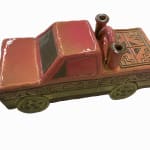

Edward Salas
Truck Vessel (Blessed 4 Life), 2021
Stoneware clay and glaze
12 x 4.5 x 5.5 in
30.5 x 11.4 x 16.5 cm
30.5 x 11.4 x 16.5 cm
Edward Salas describes the trucks as coming from an 'interest in the intersection of different cultures.' Being a first-generation Colombian American in the United States, he often thinks about 'where...
Edward Salas describes the trucks as coming from an "interest in the intersection of different cultures." Being a first-generation Colombian American in the United States, he often thinks about "where those cultures meet and what they really mean,"
Subverting and challenging the iconic symbol of the American pick-up truck, often a symbol of "masculinity, patriotism and even American exceptionalism," Salas adds decorative features from Pre-Columbian ceramics. Salas also draws inspiration from decorative car cultures from around the world: West Coast lowriders, Japanese Dekotoras, Colombian Chivas, and Pakistani Jingle Trucks.
Subverting and challenging the iconic symbol of the American pick-up truck, often a symbol of "masculinity, patriotism and even American exceptionalism," Salas adds decorative features from Pre-Columbian ceramics. Salas also draws inspiration from decorative car cultures from around the world: West Coast lowriders, Japanese Dekotoras, Colombian Chivas, and Pakistani Jingle Trucks.


